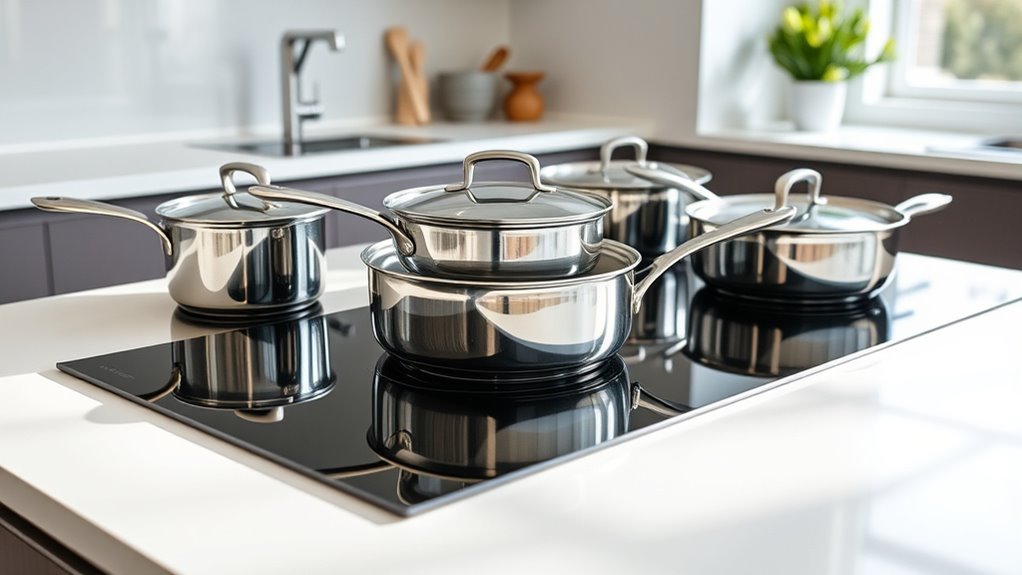To guarantee your cookware works with induction stoves, look for ferromagnetic materials like cast iron or certain stainless steels. Use a magnet on the bottom; if it sticks firmly, it’s likely compatible. Check for flat, smooth bases that match your burner size for even heating. Avoid cookware with uneven bases or no magnetic properties. If you keep these tips in mind, you’ll discover more ways to optimize your induction cooking setup.
Key Takeaways
- Use a magnet to test if the cookware’s base is ferromagnetic; a strong attraction indicates induction compatibility.
- Ensure the cookware has a flat, smooth, and properly sized base that matches your induction cooktop for optimal performance.
- Not all labeled induction cookware performs well; check for high magnetic permeability and quality construction.
- Avoid using abrasive cleaners; proper maintenance preserves the ferromagnetic properties and prevents damage.
- Confirm compatibility by inspecting the base and reviewing brand or product specifications for induction suitability.
Understanding How Induction Cooking Works
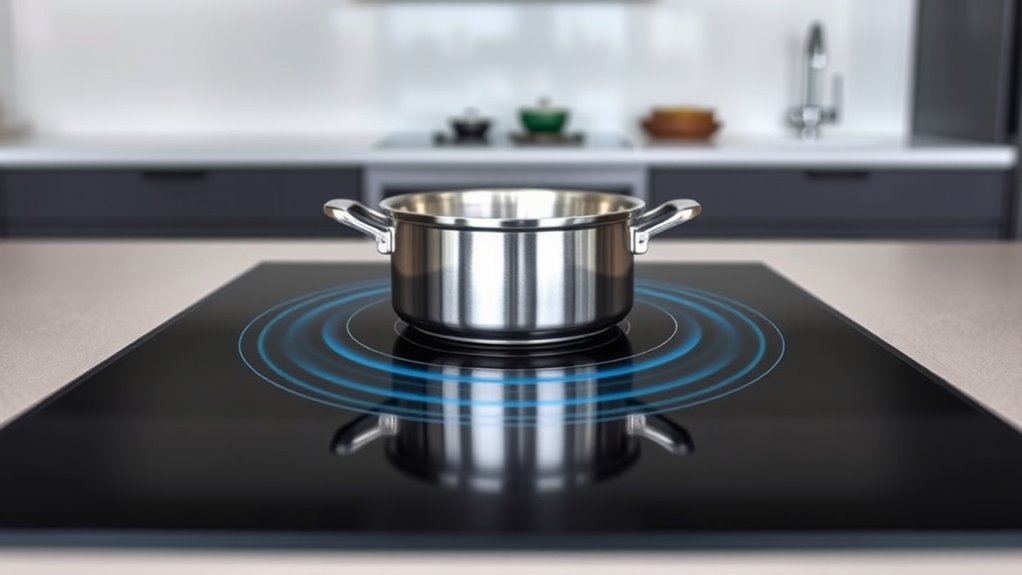
Induction cooking works by generating heat directly in the cookware through electromagnetic fields. When you place compatible cookware on an induction stove, an electromagnetic current flows through the ferromagnetic material, creating heat instantly. This process makes induction cooking highly efficient and precise. For induction cookware safety, verify your pots and pans are made from ferromagnetic materials like cast iron or certain stainless steels. Proper cookware cleaning tips include avoiding abrasive scrubbers that can damage the surface and wiping spills promptly to prevent residue buildup. Since induction stoves heat cookware directly, you don’t need to worry about hot surfaces lingering after cooking. Understanding how this technology works helps you select the right cookware and maintain it properly, ensuring safe, effective, and long-lasting use. Additionally, knowing the color accuracy of your cookware can help in monitoring heat distribution and cooking performance more effectively.
The Key Role of Ferromagnetic Materials in Cookware
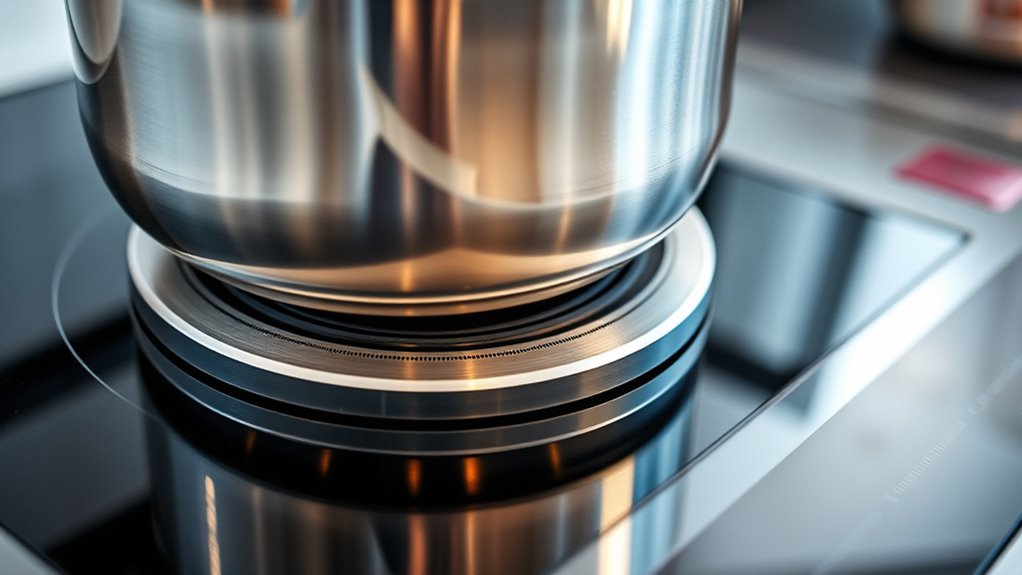
Ferromagnetic materials are essential for induction cookware because they enable efficient heat transfer through electromagnetic induction. Their ferromagnetic properties allow them to respond strongly to magnetic fields generated by your induction cooktop. This magnetic detection signals the stove that the cookware is compatible, ensuring proper operation. Materials like cast iron and certain stainless steels have high magnetic permeability, making them ideal for induction cooking. Without these ferromagnetic properties, the cooktop won’t detect the cookware, and no heat will transfer. The magnetic detection process is quick and reliable when you use ferromagnetic materials, providing precise control over cooking temperatures. Understanding this role helps you choose the right cookware to maximize induction efficiency and safety.
Identifying Induction-Compatible Cookware: Materials and Features

To determine if cookware is compatible with your induction cooktop, you need to look at the materials and features it offers. First, check for a magnetic base—this is essential for induction. Second, consider the cookware’s aesthetics; sleek, uniform surfaces often indicate quality and proper construction. Third, research the brand reputation; trusted brands tend to produce durable, reliable cookware designed for induction. Materials like cast iron, stainless steel with a magnetic layer, and certain enameled options are ideal. Avoid cookware with aluminum or glass bottoms, as they don’t work with induction unless they have a ferromagnetic layer. Recognizing these features helps you select cookware that not only performs well but also fits your style and brand preferences. Additionally, understanding the AI vulnerabilities in manufacturing processes can help ensure the durability and safety of your cookware choices.
Testing Your Existing Pots and Pans for Compatibility
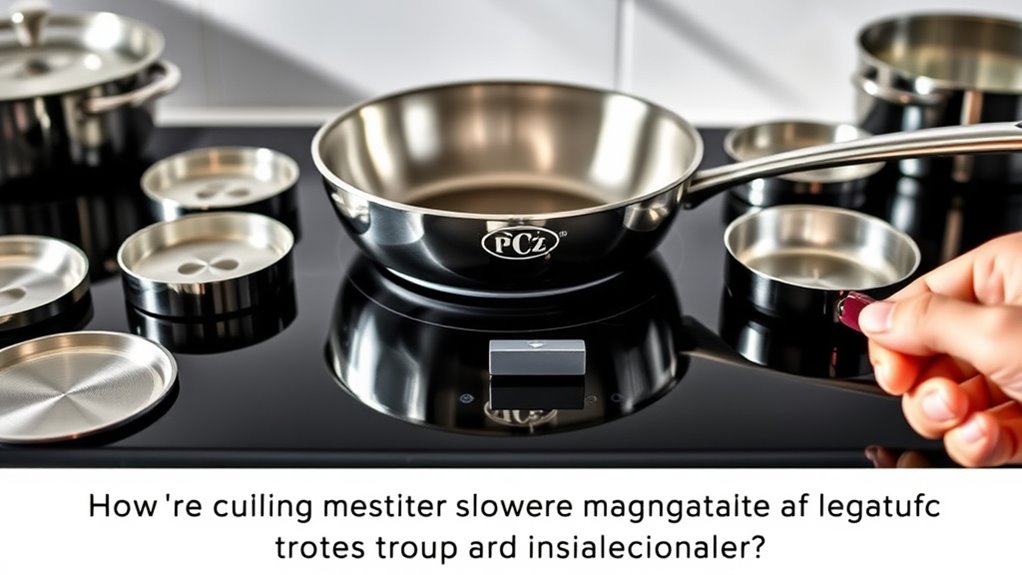
Before investing in new cookware, it’s smart to test your existing pots and pans for induction compatibility. The easiest method is to place a magnet on the bottom of each piece. If the magnet sticks firmly, your cookware is likely induction-ready. This quick test helps you avoid unnecessary purchases and preserves your cookware aesthetics, especially if you’ve invested in stylish or high-end pieces. Keep in mind that brand reputation can also guide your expectations; trusted brands often ensure better quality and compatibility. While appearance matters, functionality is key. Testing your current pots and pans lets you determine if you can continue using them on your induction stove, saving money and time, and helping you make informed decisions about future upgrades. Additionally, some cookware may require specific filtration or material properties to work effectively with induction technology.
Common Misconceptions About Induction Cookware
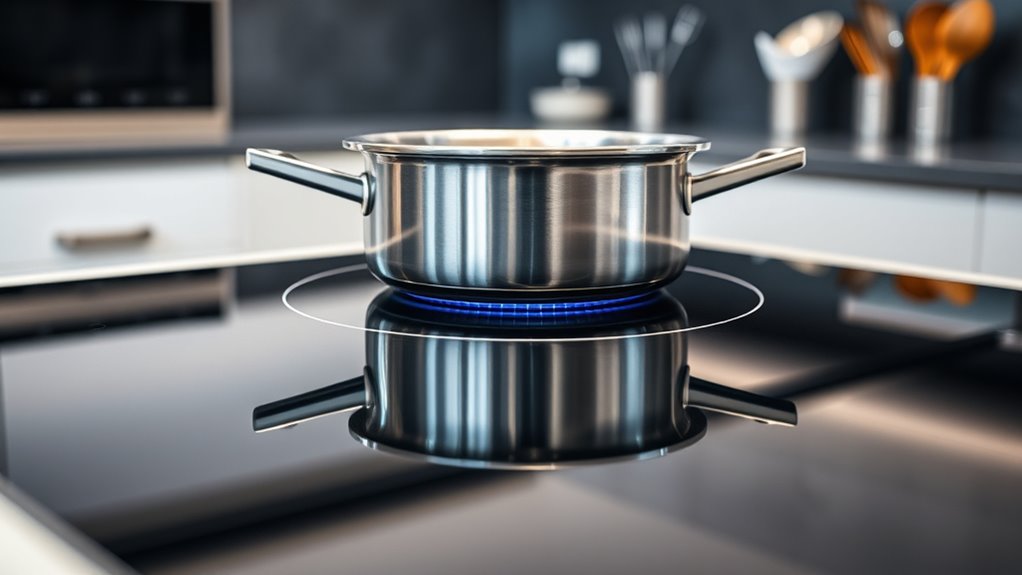
Many people believe that all cookware labeled as compatible with induction stoves works perfectly, but that’s a common misconception. This is a classic example of myth busting in cookware myths. Not all labeled items perform well; some may have weak magnetic properties or uneven bases. Imagine trying to cook with a pan that looks perfect but:
- Doesn’t heat evenly, causing hot spots and burnt spots.
- Fails to transfer heat efficiently, wasting energy.
- Loses magnetic properties over time, making it incompatible.
These issues highlight why simply trusting labels isn’t enough. Understanding magnetic strength and base quality influence performance. Knowing the truth helps you avoid costly mistakes and ensures your cookware truly works with induction stoves.
The Impact of Base Size and Flatness on Cooking Efficiency

The size and flatness of your cookware’s base directly affect heat transfer and cooking performance. A properly sized, flat base guarantees even heating, reducing hot spots and improving safety. When these factors are off, you might experience less efficiency and unstable cooking results. Using the correct cookware materials can further enhance heat conduction and overall cooking outcomes.
Heat Transfer Effectiveness
A flat, appropriately sized base is essential for effective heat transfer when using induction cookware. If your base isn’t flat or matches the burner size, energy efficiency drops, and heat distribution becomes uneven. Imagine:
- A smooth, level surface that makes direct contact with the induction element.
- Consistent contact across the entire base, minimizing hot spots.
- The base covering most of the cooking zone, optimizing heat transfer.
These factors ensure your cookware heats quickly and evenly, saving energy and reducing cooking time. Flat, well-sized bases maximize heat transfer effectiveness, allowing you to control temperatures precisely. When the base fits snugly and is flat, heat flows uniformly, improving energy efficiency and cooking results. Proper base design minimizes wasted energy and ensures reliable, even heat distribution every time. Ensuring your cookware’s base is compatible with induction stoves also involves understanding base size and flatness, which directly impacts heat transfer performance.
Stability and Safety
A well-sized and flat base doesn’t just improve heat transfer—it also plays a vital role in maintaining stability and guaranteeing safety during cooking. An uneven or small base can cause wobbling, increasing the risk of spills or accidents. Proper contact with the induction element ensures even heating and reduces the chance of hot spots. Additionally, a stable pan enhances cookware aesthetics and reflects positively on the brand reputation. To illustrate, consider this comparison:
| Feature | Impact on Safety and Performance |
|---|---|
| Flat, wide base | Better stability, safer handling |
| Small or uneven base | Wobbles, risk of spills, uneven heat |
| High-quality craftsmanship | Longer durability, improved aesthetics |
Prioritize base size and flatness for essential safety and efficiency, especially considering cookware materials that may affect base flatness and heat conduction.
How to Choose the Right Induction-Ready Cookware Sets

Choosing the right induction-ready cookware set starts with understanding how induction cooking works and what features to look for. First, verify the cookware has a flat, magnetic base for efficient heat transfer. Next, consider eco-friendly options like ceramic or recycled materials that reduce environmental impact. Finally, think about aesthetic design considerations—select sets that match your kitchen style and personal taste. Visualize a sleek set with a stainless steel finish, ergonomic handles, and vibrant color accents. Keep in mind, a well-chosen set should be durable, easy to clean, and compatible with your induction cooktop. By focusing on these key aspects, you’ll find cookware that’s both functional and beautiful, elevating your cooking experience while being mindful of sustainability.
Troubleshooting Compatibility Issues With Your Existing Cookware

If your cookware isn’t heating properly, start by checking if it has a magnetic base. You can do this by seeing if a magnet sticks firmly to the bottom. Testing with a magnet is the simplest way to determine if your existing pots and pans are compatible with induction cooktops. Additionally, ensuring your cookware is ergonomic and well-maintained can improve performance and longevity.
Identifying Magnetic Bases
To determine if your existing cookware is compatible with induction cooking, check whether its base is magnetic. A magnetic field must be able to pass through the base to activate induction zones effectively. Imagine the base acting like a magnet, drawing in the induction energy. To test this, look for a few signs:
- Place a magnet on the bottom—if it sticks firmly, your cookware likely has a magnetic base.
- Feel the bottom; a flat, smooth surface usually indicates a compatible material.
- Check for labels or markings that specify induction compatibility or magnetic properties.
- Ensuring your cookware has a magnetic base helps you avoid compatibility issues, ensuring the magnetic field from the induction zones interacts properly with your cookware for efficient cooking.
Testing Compatibility Effectively
Wondering if your cookware works with induction? The best way to test is by performing a simple compatibility check. Use a magnet: if it sticks firmly to the bottom, your cookware likely works. Keep in mind, cookware aesthetics can vary, so appearance isn’t a reliable indicator. Also, consider the brand reputation—trusted brands often design compatible cookware. To troubleshoot further, compare your existing pots with those labeled as induction-ready. Here’s a quick guide:
| Test Method | Indicator |
|---|---|
| Magnetic test | Magnet sticks firmly—likely compatible |
| Visual inspection of base | Flat, smooth base—better performance |
| Brand reputation and reviews | Good reviews suggest reliable compatibility |
Use these methods to verify compatibility before investing in new cookware. Additionally, testing compatibility ensures you get the most out of your existing pots and pans.
Investing in Quality Induction Cookware: What to Look For

Choosing quality induction cookware guarantees your cooking experience is efficient and enjoyable. To ascertain you invest wisely, look for cookware with:
- Strong material durability that withstands daily use without warping or chipping. Imagine a pot that stays sleek and sturdy after months of cooking.
- Aesthetic appeal that complements your kitchen’s style, making your space feel inviting and modern.
- Compatibility with induction technology, indicated by a magnetic base that guarantees even heat transfer.
Prioritize cookware with a solid, magnetic bottom made from stainless steel or cast iron. These materials not only last longer but also enhance your kitchen’s visual appeal, giving you both function and style in one package.
Tips for Maintaining and Extending the Life of Your Induction Cookware
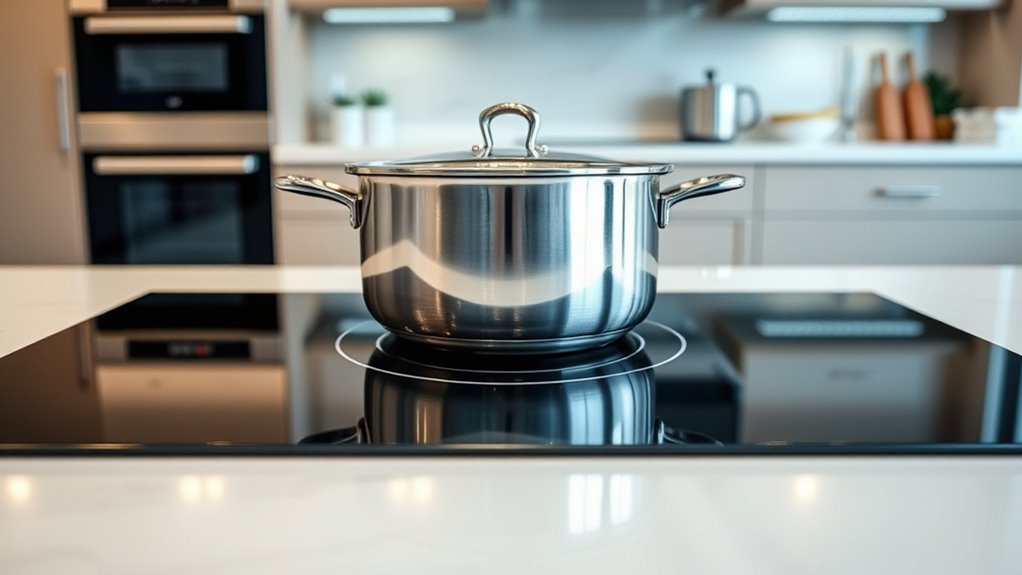
Proper maintenance is key to keeping your induction cookware in top condition and extending its lifespan. Regular cleaning routines prevent residue buildup and protect the cookware’s surface, so wash it with gentle dish soap and a soft sponge after each use. Avoid abrasive scrubbers that can scratch the surface. When storing, verify your cookware is completely dry to prevent rust or corrosion, and stack them carefully with soft padding or individual protectors to avoid scratches. Store in a dry, cool place away from direct sunlight. Also, avoid sudden temperature changes, like running cold water on a hot pan, which can warp or damage the material. By following these simple storage tips and cleaning routines, you’ll preserve your induction cookware’s performance and extend its overall life.
Frequently Asked Questions
Can Non-Metallic Cookware Be Used on Induction Stovetops?
Non-metallic cookware isn’t induction compatible because induction stovetops require magnetic material to generate heat. If you want to use non-metallic cookware, you’ll need a compatible induction interface disk or converter plate. These devices sit between your stovetop and non-metallic cookware, enabling induction compatibility. Without them, non-metallic cookware won’t work on induction stovetops, so it’s essential to check your cookware’s material and consider options to make it compatible.
Does Cookware Age Affect Induction Compatibility?
Your cookware’s age and durability definitely affect its induction compatibility. Over time, age-related wear can damage the ferromagnetic layer needed for induction cooking, making it less effective. Even if your pots and pans seem sturdy, cracks or warping might hinder magnetic energy transfer. To guarantee proper performance, regularly check for signs of wear and consider replacing older cookware that no longer responds well on your induction stovetop.
Are There Safety Concerns With Incompatible Induction Cookware?
Imagine incompatible cookware as a broken shield—risking fire hazards and cookware damage. You should be aware that using ill-suited pots on induction can lead to overheating, sparks, or even fires. This not only endangers your safety but also damages your cookware, reducing its lifespan. Always guarantee your cookware is compatible to prevent these hazards, keeping your kitchen safe and your cookware in good shape.
How Do I Test if My Cookware Works on Induction Without a Magnet?
You can test if your cookware works on induction by checking if a magnet sticks to its bottom; this indicates a magnetic field that induction sensors detect. If you don’t have a magnet, look for a label or marking showing compatibility. Alternatively, place your cookware on the induction stove; if the sensor detects a magnetic field and heats up, it’s induction-compatible. This quick test confirms your cookware’s suitability.
Can I Use Induction-Compatible Cookware on Traditional Electric Stoves?
Yes, you can use induction-compatible cookware on traditional electric stoves. Just guarantee your cookware is in good condition to maintain safety and ideal performance. Regularly check for warping or damage, as these affect induction safety and cookware maintenance. Keep in mind that the heat transfer may differ, so adjust your cooking techniques accordingly. Always follow manufacturer guidelines for both your cookware and stove to ensure safe, efficient cooking.
Conclusion
Now that you know the secrets behind induction cookware, you’re armed with the tools to navigate your kitchen with confidence. Think of your cookware as the loyal crew on a high-tech ship—when they’re compatible, everything sails smoothly. Don’t let misconceptions sink your culinary ship. With the right pieces and a bit of know-how, you’ll turn your induction stove into a powerhouse of precision and performance, making every meal a smooth voyage.

